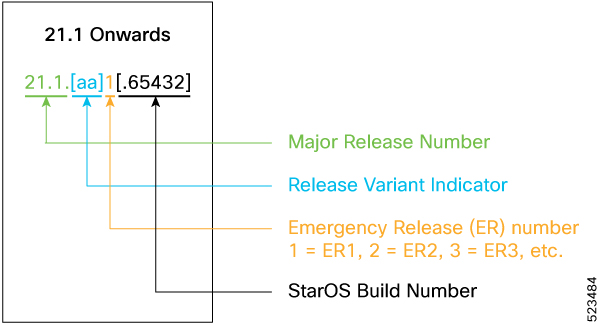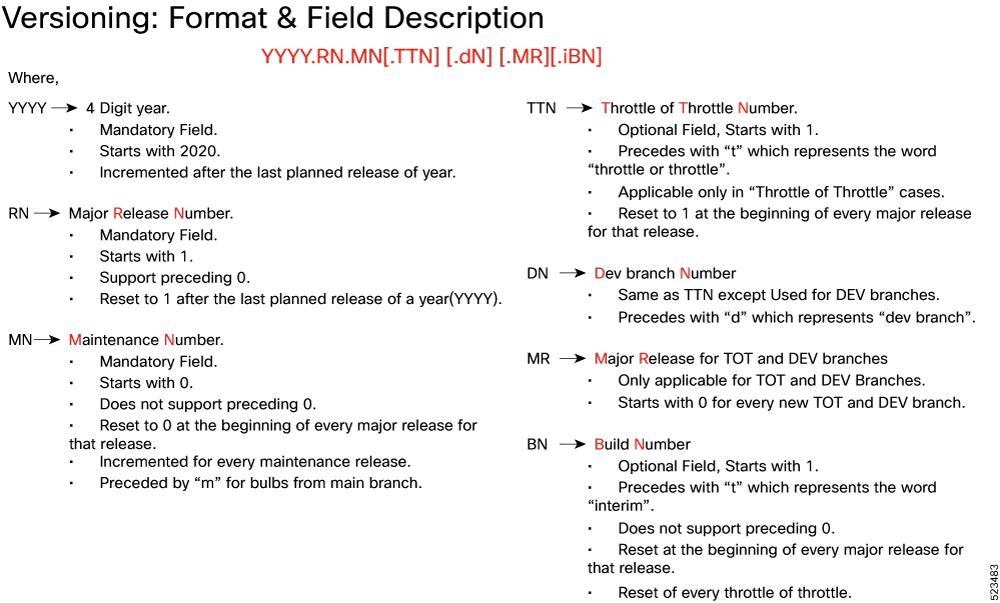Ultra Cloud Core User Plane Function
Introduction
This Release Notes identifies changes and issues related to this software release.
Release Lifecycle Milestones
|
Release Lifecycle Milestone |
Milestone |
Date |
|---|---|---|
|
First Customer Ship |
FCS |
31-Jan-2025 |
|
End of Life |
EoL |
31-Jan-2025 |
|
End of Software Maintenance |
EoSM |
1-Aug-2026 |
|
End of Vulnerability and Security Support |
EoVSS |
1-Aug-2026 |
|
Last Date of Support |
LDoS |
31-Aug-2027 |
These milestones and the intervals between them are defined in the Cisco Ultra Cloud Core (UCC) Software Release Lifecycle Product Bulletin available on cisco.com.
Release Package Version Information
|
Software Packages |
Version |
|---|---|
|
companion-vpc-2025.01.0.zip.SPA.tar.gz |
2025.01.0 (21.28.m32.96733) |
|
qvpc-si-2025.01.0.bin.SPA.tar.gz |
2025.01.0 (21.28.m32.96733) |
|
qvpc-si-2025.01.0.qcow2.zip.SPA.tar.gz |
2025.01.0 (21.28.m32.96733) |
|
NED package |
ncs-6.1.14-cisco-staros-5.54.1 |
|
NSO |
6.1.14 |
Use this link to download the NED package associated with the software.
Descriptions for the various packages provided with this release are available in the Release Package Descriptions section.
Verified Compatibility
|
Products |
Version |
|---|---|
|
ADC Plugin |
2.74.6.2587 |
|
RCM |
2025.01.0.i213 |
|
Ultra Cloud Core SMI |
2025.01.1.i14 |
|
Ultra Cloud Core SMF |
2025.01.0 |
What's New in This Release
Features and Enhancements
This section covers a brief description of the features and enhancements introduced in this release. It also includes links to detailed documentation, where available.
| Feature | Description | ||
|---|---|---|---|
|
3GPP LI Support |
The 3GPP LI support is enhanced to adhere to the 3GPP standards for lawful interception. UPF supports message formats for Sxa and combo calls as per 3GPP LI standard. For more information, contact your Cisco account representative. |
||
|
Identify URR Associated With Matching Rule Using a Single Command |
This release introduces a consolidated command for UP to provide a comprehensive overview of per subscriber details, including:
This enhancement eliminates the need to use multiple commands across the UP or UP and CP to extract and correlate this information per subscriber. Command Introduced: show subscribers user-plane-only callid callid rule-match-info { [full] all | rulename rulename } . Default Setting: Enabled – Always-on |
||
|
This feature allows IoT application traffic to be prioritized using ToS values received from cnPGW through dynamic rules. The UPF applies these values to manage data packet traffic efficiently. These changes are visible in the show subscribers user-plane-only full all command. Default Setting: Enabled – Always-on |
|||
| Scaling UPF Capacity for IoT Use Cases |
This release includes hardware optimization within the UPF deployment to support a mixed call model that accommodates a combination of telematics, infotainment, and IoT use cases. The session distribution is set at 75% for telematics, 20% for IoT, and 5% for infotainment.
|
Behavior Changes
This section covers a brief description of behavior changes introduced in this release.
| Behavior Change | Description |
|---|---|
|
Correction of Metric for the VPP CPU Usage |
Previous Behavior: It was considered that the VPP CPU usage remains typically high, ranging from 90-100%. Hence, the reported metric was scaled on a range of 1-100%. However, this VPP CPU usage, was of main thread and not the worker threads. New Behavior: The aggregate VPP CPU usage of worker threads is usually low, ranging between 10% and 30%. Hence, the reported metric is used as-is, without scaling. |
|
Enhancement in the Session Priority Profile Configuration |
Previous Behavior: The 'throttle keyword in the Session Priority Profile had a default value of ‘Disabled’, if the priority is not configured. Also, the existing statistics were not reflecting the complete data and session level statistics when system is in overload or self-protection state. New Behavior: The throttle keyword in the Session Priority Profile, has the default value as ‘Enabled’, if the priority is not configured. New session and data level statistics are added when system is in overload or self-protection state. These statistics are displayed as part of the show command show user-plane-service statistics name and show user-plane-service statistics all. |
Installation and Upgrade Notes
This Release Note does not contain general installation and upgrade instructions. Refer to the existing installation documentation for specific installation and upgrade considerations.
Software Integrity Verification
To verify the integrity of the software image you have from Cisco, you can validate the SHA512 checksum information against the checksum identified by Cisco for the software.
Image checksum information is available through Cisco.com Software Download Details. To find the checksum, hover the mouse pointer over the software image you have downloaded.
The following screenshot is an example of a UPF release posted in the Software Download page.

At the bottom you find the SHA512 checksum, if you do not see the whole checksum you can expand it by pressing the "..." at the end.
To validate the information, calculate a SHA512 checksum using the information in Table 1 and verify that it matches either the one provided on the software download page.
To calculate a SHA512 checksum on your local desktop, refer to the following table.
|
Operating System |
SHA512 checksum calculation command examples |
|---|---|
|
Microsoft Windows |
Open a command line window and type the following command: |
|
Apple MAC |
Open a terminal window and type the following command: |
|
Linux |
Open a terminal window and type the following command: OR |
|
NOTES: filename is the name of the file. extension is the file extension (for example, .zip or .tgz). |
|
If the SHA512 checksum matches, you can be sure that no one has tampered with the software image or the image has not been corrupted during download.
If the SHA512 checksum does not match, we advise you to not attempt upgrading any systems with the corrupted software image. Download the software again and verify the SHA512 checksum again. If there is a constant mismatch, please open a case with the Cisco Technical Assistance Center.
Certificate Validation
UPF software images are signed via x509 certificates. Please view the .README file packaged with the software for information and instructions on how to validate the certificates.
Open Bugs for This Release
The following table lists the open bugs in this specific software release.
 Note |
This software release may contain open bugs first identified in other releases. Additional information for all resolved bugs for this release are available in the Cisco Bug Search Tool. |
|
Bug ID |
Headline |
|---|---|
| Sessmgr restart at snx_uplane_driver_request_control_dispatch() | |
|
Sessmgr restarted at sessmgr_uplane_update_stats() |
|
|
CRR recovery failure recovery-invalid-crr-clp-uplane-record-info observed with ICSR UPF swo |
|
|
Continuous fapi /sessmgr error logs seen " FAPI stream operation failure for operation type" |
|
|
uplane recieved duplicate URR error logs observed after sessmgr recovery on RCM active UPF |
|
|
Error logs seen with sessctrl task kill |
|
|
From hermes p2p build to non-hermes p2p build upgrade getting failed with hermes UPF build |
|
|
Seen call-recovery-uplane-flow-filter-failure on N:M UPF during back to back SWO for upgrade test |
Resolved Bugs for This Release
The following table lists the resolved bugs in this specific software release.
 Note |
This software release may contain open bugs first identified in other releases. Additional information for all open bugs for this release are available in the Cisco Bug Search Tool. |
|
Bug ID |
Headline |
Behavior Change |
|---|---|---|
|
Multiple sessmgr ,aaamgr, vpnmgr, hatsystem restarts with evlogd at 100% cpu leading to call loss |
No |
Operator Notes
StarOS Version Numbering System
The output of the show version command displays detailed information about the version of StarOS currently running on the ASR 5x00 or Cisco Virtualized Packet Core platform.
The Version Build Number for releases 21.1 and later include a major and emergency release number, for example, "21.1.1".

The appropriate version number field increments after a version has been released. The new version numbering format is a contiguous sequential number that represents incremental changes between releases. This format facilitates identifying the changes between releases when using Bug Search Tool to research software releases.
 Note |
The 5G UPF software is based on StarOS and implements the version numbering system described in this section. However, as a 5G network function (NF), it is posted to Cisco.com under the Cloud Native Product Numbering System as described in Cloud Native Product Version Numbering System. |
Cloud Native Product Version Numbering System
The show helm list command displays detailed information about the version of the cloud native product currently deployed.

The appropriate version number field increments after a version has been released. The new version numbering format is a contiguous sequential number that represents incremental changes between releases. This format facilitates identifying the changes between releases when using Bug Search Tool to research software releases.
Release Package Descriptions
The following table provides descriptions for the packages that are available with this release.
|
Software Packages |
Description |
|---|---|
|
companion-vpc-<staros_version>.zip.SPA.tar.gz |
Contains files pertaining to VPC, including SNMP MIBs, RADIUS dictionaries, ORBEM clients, etc. These files pertain to both trusted and non-trusted build variants. The VPC companion package also includes the release signature file, a verification script, the x.509 certificate, and a README file containing information on how to use the script to validate the certificate. |
|
qvpc-si-<staros_version>.bin.SPA.tar.gz |
The UPF release signature package. This package contains the VPC-SI deployment software for the UPF as well as the release signature, certificate, and verification information. Files within this package are nested under a top-level folder pertaining to the corresponding StarOS build. |
|
qvpc-si-<staros_version>.qcow2.zip.SPA.tar.gz |
The UPF release signature package. This package contains the VPC-SI deployment software for the UPF as well as the release signature, certificate, and verification information. Files within this package are nested under a top-level folder pertaining to the corresponding StarOS build. |
|
ncs-<nso_version>-cisco-staros-<version>.signed.bin |
The NETCONF NED package. This package includes all the files that are used for NF configuration. Note that NSO is used for NED file creation. |
Obtaining Documentation and Submitting a Service Request
For information on obtaining documentation, using the Cisco Bug Search Tool (BST), submitting a service request, and gathering additional information, refer to https://www.cisco.com/c/en/us/support/index.html.
 Feedback
Feedback